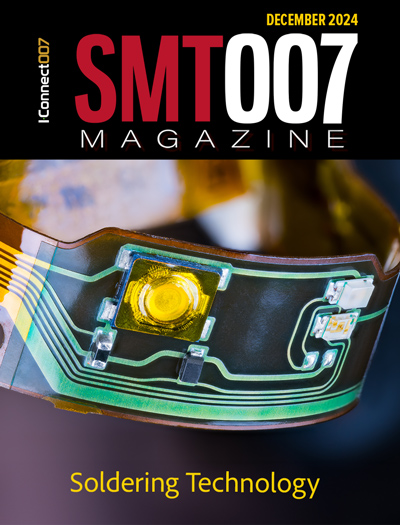-

- News
- Books
Featured Books
- smt007 Magazine
Latest Issues
Current Issue
Technical Resources
Key industry organizations–all with knowledge sharing as a part of their mission–share their technical repositories in this issue of SMT007 Magazine. Where can you find information critical to your work? Odds are, right here.

The Path Ahead
What are you paying the most attention to as we enter 2025? Find out what we learned when we asked that question. Join us as we explore five main themes in the new year.

Soldering Technologies
Soldering is the heartbeat of assembly, and new developments are taking place to match the rest of the innovation in electronics. There are tried-and-true technologies for soldering. But new challenges in packaging, materials, and sustainability may be putting this key step in flux.
- Articles
- Columns
Search Console
- Links
- Media kit
||| MENU - smt007 Magazine
Flexible Bipolar Plates Made of Polymers Make It Possible to Build Compact Batteries
January 25, 2019 | Fraunhofer IISBEstimated reading time: 3 minutes
Whether used for power supply or in electric cars, current battery systems are based on a series of interconnected individual cells, which has certain disadvantages in terms of efficiency and manufacturing. Bipolar battery setups, in contrast, comprise compact stacks of individual cells. A new type of flexible and extremely thin bipolar plate allows batteries to be manufactured cost effectively.
Conventional battery systems are extremely complex. They usually consist of several individual cells that are connected with each other via wires. Not only is this costly and time-consuming, it also entails the danger of hot spots—areas in which the wires get too hot. In addition, every single one of these cells has to be packaged, meaning that a large portion of the battery consists of inactive material that does not contribute to battery performance. Bipolar batteries are designed to solve this problem by connecting the individual cells with each other using flat bipolar plates. However, this gives rise to other challenges: either the bipolar plates are made of metal and are thus prone to corrosion, or they are made of a carbon-polymer composite, in which case they have to be at least several millimeters thick as a result of the manufacturing process.
Material Savings of More Than 80%
Researchers at the Fraunhofer Institute for Environmental, Safety and Energy Technology UMSICHT in Oberhausen have now developed an alternative. “We manufacture bipolar plates from polymers that have been made electrically conductive,” says Dr.-Ing. Anna Grevé, department head at Fraunhofer UMSICHT. “In this way, we can produce very thin plates and—compared with conventional cells connected by wires—save over 80% of the material used.” In addition, the material offers numerous other advantages, such as the fact that it does not corrode. Another major advantage is that the material can be subsequently reshaped. This makes it possible, for example, to emboss structures, which are important for fuel cells. Moreover, the innovative new bipolar plates can be welded together, so the resulting battery system is absolutely tight. Conventional bipolar plates, in contrast, are unsuitable for welding due to the thermal and mechanical stressing of the material during manufacture. Joining them in such a way that neither gases nor liquids can pass through the joints requires seals. However, seals become quickly porous, and they also take up space. A further advantage of the new material is that the researchers are able to adapt the properties of the bipolar plates to specific requirements. “We can make plates that are so flexible that you can wrap them around your finger, as well as ones that are completely stiff,” specifies Grevé.
Cost-Effective Manufacture through Roll-To-Roll Technique
The primary challenge consisted in developing the material and the manufacturing process. “We use commercially available polymers and graphites, but the secret is in the recipe,” says Grevé. As the material is made up of about 80% graphites and only about 20% polymer, the processing methods have little in common with ordinary polymer processing. The team of researchers at Fraunhofer UMSICHT opted for the roll-to-roll technique, which allows cost-effective manufacturing, and adapted it using a lot of know-how. After all, the ingredients that go into the manufactured plates must be distributed homogeneously, and the plates also have to be mechanically stable and completely tight. Because of the initial structure of the materials, this was no easy feat. However, the experts also mastered this challenge. “We were able to fulfill all requirements in one process. Consequently, the plates can be used just as they are when they come out of the machine,” explains Grevé. Another advantage of the technique is that the plates can be manufactured in any size.
Suggested Items
Summit Interconnect Welcomes Leo LaCroix as Vice President of Aerospace & Defense Operations
02/21/2025 | Summit Interconnect, Inc.Summit Interconnect, a leading provider of advanced printed circuit board (PCB) solutions, is pleased to announce that Leo LaCroix has joined the company as Vice President of Aerospace & Defense Operations. In this role, LaCroix will oversee operational strategy, customer engagement, and manufacturing excellence for Summit’s aerospace and defense-focused facilities, driving continued growth and innovation in the sector.
SEMIEXPO Heartland to Spotlight Smart Manufacturing, Smart Mobility
02/21/2025 | SEMISEMIEXPO Heartland, SEMI’s first Midwestern U.S. exposition to be held April 1-2 at the Indiana Convention Center in Indianapolis, will feature a conference program highlighting the latest developments in smart manufacturing and smart mobility.
The Test Connection Celebrates Its 45-Year Test and Training Legacy at IPC APEX EXPO 2025
02/20/2025 | The Test Connection Inc.The Test Connection Inc. (TTCI), a leading provider of electronic test and manufacturing solutions, is proud to announce its participation in the 2025 IPC APEX EXPO.
BAE Systems Significantly Expands Endicott Operations to Support Aircraft Electrification
02/20/2025 | BAE SystemsBAE Systems, a leading aerospace technology company, is expanding its operations in Endicott, New York, with a 150,000 square feet addition to its existing footprint. The dedicated facility will be equipped for high-voltage energy storage systems (ESS) development, manufacturing, and field support, advancing sustainable aviation solutions.
Arch Systems to Showcase AI-Powered Automated Downtime Labeling at IPC APEX EXPO 2025
02/20/2025 | Arch SystemsArch Systems, a leader in machine data, AI, and analytics for manufacturers, will exhibit at the 2025 IPC APEX EXPO, taking place from March 18-20 at the Anaheim Convention Center in California. Visitors can explore Arch's latest innovations at Booth #1102, where the company will introduce Arch Systems’ Automated Downtime and its collaborative efforts in global electronics manufacturing.


